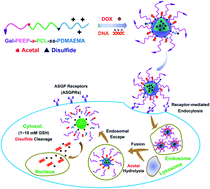, (倪沛红)
a College of Chemistry, Chemical Engineering and Materials Science, Jiangsu Key Laboratory of Advanced Functional Polymer Design and Application, Soochow University, Suzhou 215123, P. R. China
Polym. Chem. 2014, 5, 5124-5138
Novel galactosamine (Gal)-modified polymeric micelles which were responsive to both reduction (via the disulfide group, -ss-) and pH (acetal group, -a-) were constructed from poly(ethylethylene phosphate)-a-poly(ε-caprolactone)-ss-poly[2-(dimethylamino)ethyl methacrylate] (Gal-PEEP-a-PCL-ss-PDMAEMA) terpolymers in order to develop a multifunctional bioreducible system for the targeted co-delivery of anticancer drugs and DNA. These multifunctional terpolymers were synthesized via a combination of ring-opening polymerization (ROP), atom transfer radical polymerization (ATRP) and a Cu(I)-catalyzed azide-alkyne cycloaddition (CuAAC) "click" reaction. The chemical structures, chemical compositions, the molecular weights and molecular weight distributions of these terpolymers have been fully characterized, and their self-assembly behavior was studied in detail. The interaction between the terpolymers and DNA was studied by an agarose gel retardation assay. The physical properties of the resulting polyplexes were further determined by zeta potential, dynamic light scattering (DLS) and TEM analyses. The micelles containing the acetal and disulfide groups could be dissociated in an intracellular environment. The reduction- and pH-triggered release of doxorubicin (DOX) from DOX-loaded micelles showed that the release of DOX was accelerated at pH 5.0 and pH 7.4 with 10 mM cytoplasmic glutathione (GSH), and that the release rate was further enhanced at pH 5.0 with 10 mM GSH. A methyl thiazolyl tetrazolium (MTT) assay indicated that the blank micelles displayed relatively low cytotoxicity towards HeLa and HepG2 cells. Although the DOX-loaded micelles could efficiently prohibit the growth of both cell types, they exhibited much higher cytotoxicity towards HepG2 cells than HeLa cells. In addition, the intracellular uptake and transfection of Gal-PEEP-a-PCL-ss-PDMAEMA/DNA/DOX polyplexes into HepG2 cells was more efficient than that into HeLa cells, as revealed by a live cell imaging system, owing to specific ligand–receptor interactions between Gal and asialoglycoprotein receptors overexpressed on the surface of HepG2 cells. These results provide a facile strategy for the preparation of multifunctional biodegradable polymeric micelles that may act as a promising platform for the targeted intracellular co-delivery of hydrophobic drugs and nucleic acids.

链接:
//pubs.rsc.org/en/Content/ArticleLanding/2014/PY/C4PY00538D#!divAbstract